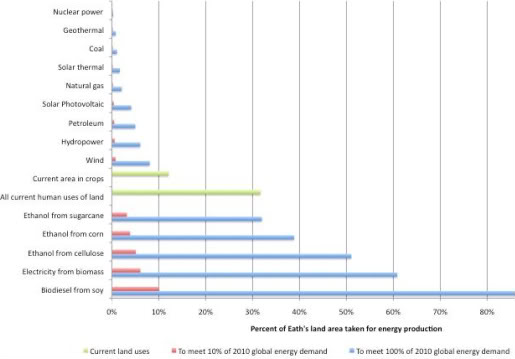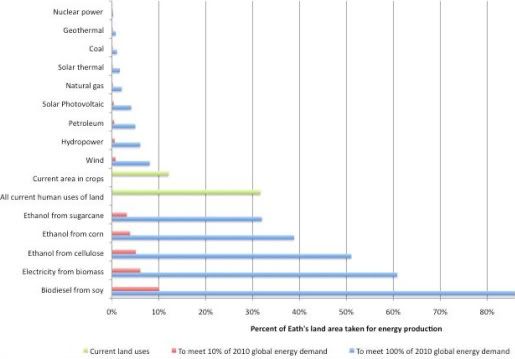Energy Policy and Land Use

The migration to renewable energy is complicated by a great number of factors in the renewable energy “triumvirate” -technological, economic, and political. The chart below shows one of many different dimensions of this complexity: land use – which, when you think about it, touches on all three. The data in the chart is derived from:
1) a paper titled Alternative Energy and Land Use from Clinton Andrews et al.
2) land intensiveness data from McDonald et al (2009)
3) land area data from Melillo et al (2009), and
4) global energy demand data from EIA
Obviously, the less land required for a given energy solution the better—and, as suggested here, this is part of the reason that corn ethanol is such a poor solution. But land use as a criterion can bring us to poor solutions as well. Some ideas for your consideration:
Hydro looks great, doesn’t it? Throw a device out in the ocean and capture the enormous power available from deep-water currents. But those devioces are expensive, they fall apart, and they come with dozens of different eco-hazards themselves.
Fossil fuels are a time-honored solution. Just poke a few holes in the ground and suck the good stuff right out. But oops, by most accounts that “good stuff” is running out, and most of those holes are controlled by the bad guys.
Got coal? Using the fuel is choking us to death, and disposing of the waste is poisoning the land.
Think nukes are safe? Before you make up your mind, Google “nuclear power plant leak” and read some of the 360,000 hits – or “nuclear waster disposal” and spend a few minutes with the 3.78 million articles you’ll find.
Again, let’s not lose site of the enormously difficult calculus facing us here. While the optimum solution doesn’t use a huge landmass, it’s also inexpensive, reliable, safe, scaleable, and not likely to cause negative unintended consequences. And this is exactly why I favor solar thermal (concentrated solar power).


[…] however, insofar as, in truth, the question at hand is moot, for several reasons surrounding the economics and politics of energy. For […]